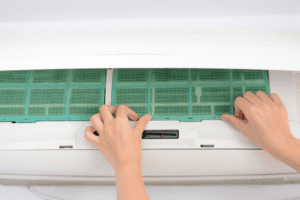Of all the critical components in your furnace or air conditioning system, one of the most vital for its long-term functionality is the filter. Not only do the filters in your HVAC systems help to cut down on the amount of dust and allergens that circulate through your home, but they also keep that dust from settling inside the unit itself. Too much dust can cause all kinds of costly problems for your system. That raises a question HVAC contractors hear frequently: what type of filter is best? One popular option, called electrostatic filters, claims to achieve far better results than more traditional choices. Is that really true, and should you switch to an electrostatic filter for your HVAC setup?
What Are Electrostatic Filters?
A traditional air filter has a straightforward method of action: it uses a microscopic mesh to trap the particles floating through the air. These particles could be dust, mites, pet dander, and other allergens that can impact air quality. Over time, this mesh fills up with the debris it traps, which is why filters often look very dark when you remove them during a monthly change. Most regular filters are only good for a single use before replacement.
Electrostatic filters differ; they’re meant to be used and reused for many months. An electrostatic filter uses a special sandwich of material layers that creates a charge of static electricity when the air flows over and through them. This static electricity attracts airborne particles like a magnet, causing them to stick to the filter media while cleaner air flows into the system. When the filter becomes dirty, you rinse it out, allow it to dry, and put it back in place.
The Benefits of Using an Electrostatic Filter
For homeowners and those who maintain commercial HVAC systems, electrostatic filters may offer a range of benefits that could make them a worthwhile investment. Some of those benefits include:
- Less waste and less money spent on disposable filter products. Reducing the amount of trash you generate is a simple step one can take to protect the environment, and using a washable electrostatic filter can help you save over the long term.
- Less hassle when it’s time to change the filter. Since all you need to do is remove and wash an electrostatic filter before it’s ready to go back to work, you can stick to a regular schedule. When you run out of disposable filters, it’s tempting to leave a dirty one in place longer than you should.
- Safeguard the efficiency of your unit. Most electrostatic filters have a MERV rating high enough to still promote good airflow without being overly restrictive. Thus, you can enjoy good performance and better air quality at the same time.
The Downside of Electrostatic Products
Although electrostatics can offer many benefits when it comes to maintaining your HVAC system, they aren’t perfect. They may not even always be the right choice. Some of the important drawbacks to keep in mind when evaluating these filters include:
- They are not as efficient as most disposable filters. Although the static electric action of the filter does work, it simply cannot capture particles to the same degree that other pleated filters can. As a result, homes where individuals with allergies live should not use electrostatics. They allow too many particles of a larger size to continue to slip into the HVAC ducting.
- More frequent cleaning may be necessary in some cases. Do you have a smoker living in your home, for example? If you do not stay on top of checking your filter regularly, it can become so dirty as to be virtually ineffective. That’s bad for your HVAC equipment and for the air quality in your home, too.
- Higher up-front cost. Though you’ll be able to save by avoiding purchasing new filters every month, you may find that electrostatic filters have a heftier price tag when you make an initial purchase.
In some cases, electrostatics are a fine filter option. However, the science is otherwise clear: they cannot outperform highly rated traditional filters, especially those that meet the criteria for HEPA filtration.
So Which Type of Filter Should You Choose?
Although the manufacturers of electrostatic filters make some pretty big claims, it’s clear that not all of them are 100% accurate. While electrostatic options are an excellent way to save money and add more convenience to your home maintenance routines, their efficacy in comparison to other options might not be enough to sway you to switch. Ultimately, the best option is the one that provides your HVAC setup with the optimum operating conditions. The easiest way to determine what filtration option is right for your home? Talk to an HVAC contractor you can trust and learn from their professional insights. When it comes to protecting your family from allergens and your equipment from damage, it’s always worth taking the time to make the right choice.

